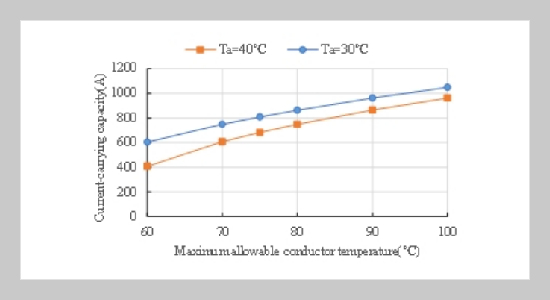REFERENCES
- [1] CIGRE WG C2.21. Lessons Learnt from Recent Emergencies and Blackout Incidents. Paris, France: GIGRE, 2015.
- [2] Ning Zhou and Xiaofu Xiong. Electrical and Meteorological Technology and Its application. Beijing, China: China Electric Power Press, 2015.
- [3] Ye Zhang, Xinbo Huang, Xiaoxiong Chen, Kehong Zhou, and Fei Zhang. Intelligent early-warning system for preserving transmission line from external damage. Gaoya Dianqi/High Voltage Apparatus, 51(8):54–61, 2015.
- [4] Xiaoge Huang, Zhijun Qin, and Hui Liu. A Survey on Power Grid Cyber Security: From Component-Wise Vulnerability Assessment to System-Wide Impact Analysis. IEEE Access, 6:69023–69035, 2018.
- [5] Mohamed A. Ibrahim. Disturbance Analysis for Power Systems. Disturbance Analysis for Power Systems, 2011.
- [6] Zhuoyao Wang, Mahshid Rahnamay-Naeini, Joana M. Abreu, Rezoan A. Shuvro, Pankaz Das, Andrea A. Mammoli, Nasir Ghani, and Majeed M. Hayat. Impacts of operators’ behavior on reliability of power grids during cascading failures. IEEE Transactions on Power Systems, 33(6):6013–6024, nov 2018.
- [7] Jian Wang. Research on Meteorological Disaster Risk Analysis and Fault Early Warning Methods for Overhead Transmission Lines. Chongqing University, 2016.
- [8] M Farzaneh, S.F., and W. A. Chisholm. Electrical Design of Overhead Power Transmission Lines. McGraw Hill Professional, 1(4):53, 2013.
- [9] F Kiessling, P Nefzger, JF Nolasco, and U Kaintzyk. Overhead Power Lines Planning, Design, Construction. Berlin, Heidelberg: Springer Berlin Heidelberg, 2014.
- [10] Franc Jakl and Andrej Jakl. Effect of elevated temperatures on mechanical properties of overhead conductors under steady state and short-circuit conditions. IEEE Transactions on Power Delivery, 15(1):242–246, jan 2000.
- [11] G. Andersson, P. Donalek, R. Farmer, N. Hatziargyriou, I. Kamwa, P. Kundur, N. Martins, J. Paserba, P. Pourbeik, J. Sanchez-Gasca, R. Schulz, A. Stankovic, C. Taylor, and V. Vittal. Causes of the 2003 major grid blackouts in North America Europe, and recommended means to improve system dynamic performance. IEEE Transactions on Power Systems, 20(4):1922–1928, nov 2005.
- [12] Yongjie Fang. Lessons from september 8, 2011 Southwest America blackout for prevention and control of cascading outages. Dianli Xitong Zidonghua/Automation of Electric Power Systems, 36(15):1–7, aug 2012.
- [13] Xin Zhou Dong, Run Bin Cao, Bin Wang, Shen Xing Shi, and Dominik Bak. India blackout and three functions of protective relay. Dianli Xitong Baohu yu Kongzhi/Power System Protection and Control, 41(2):19–25, 2013.
- [14] Soheila Karimi, Petr Musilek, and Andrew M Knight. Dynamic thermal rating of transmission lines: A review. Renewable and Sustainable Energy Reviews, 91:600–612, aug 2018.
- [15] David L. Alvarez, F. Faria da Silva, Enrique E. Mombello, Claus Leth Bak, Javier A. Rosero, and Daníel Leó Ólason. An approach to dynamic line rating state estimation at thermal steady state using direct and indirect measurements. Electric Power Systems Research, 163:599–611, 2018.
- [16] Mahbubur Rahman, Valentina Cecchi, and Karen Miu. Power handling capabilities of transmission systems using a temperature-dependent power flow. Electric Power Systems Research, 169:241–249, apr 2019.
- [17] Leanne Dawson and Andrew M. Knight. Applicability of Dynamic Thermal Line Rating for Long Lines. IEEE Transactions on Power Delivery, 33(2):719–727, apr 2018.
- [18] CIGRE WG B2.36. Guide for Application of Direct Real-Time Monitoring Systems. Paris, France: GIGRE, 2012.
- [19] Zhuangli Hu, Tong He, Yihui Zeng, Xiangyuan Luo, Jiawen Wang, Sheng Huang, Jianming Liang, Qinzhang Sun, Hengbin Xu, and Bin Lin. Fast image recognition of transmission tower based on big data. Protection and Control of Modern Power Systems, 3(1):15, dec 2018.
- [20] Leena Matikainen, Matti Lehtomäki, Eero Ahokas, Juha Hyyppä, Mika Karjalainen, Anttoni Jaakkola, Antero Kukko, and Tero Heinonen. Remote sensing methods for power line corridor surveys. ISPRS Journal of Photogrammetry and Remote Sensing, 119:10–31, sep 2016.
- [21] Chi Chen, Bisheng Yang, Shuang Song, Xiangyang Peng, and Ronggang Huang. Automatic clearance anomaly detection for transmission line corridors utilizing UAV-Borne LIDAR data. Remote Sensing, 10(4):613, apr 2018.
- [22] Junaid Ahmad, Aamir Saeed Malik, Likun Xia, and Nadia Ashikin. Vegetation encroachment monitoring for transmission lines right-of-ways: A survey. Electric Power Systems Research, 95:339–352, feb 2013.
- [23] . China National Standards. GB 50545-2010 Code for Design of 110 kV˜750 kV Overhead Transmission Line. Beijing, China: China Planning Press, 2010.
- [24] International Electrotechnical Commission. IEC 60826-2003 Design criteria of overhead transmission lines. Geneva, Switzerland: International Electrotechnical Commission, 2003.
- [25] Ke Sun and Jian Qin Liu. Analysis on Differentiated Planning of the Power Grid. Electric Power Technologic Economics, 21(2):42–45, 2009.
- [26] Chunli Song, Dichen Liu, Jun Wu, Haolei Wang, and Feifei Dong. Differential Power Network Planning Considering Weather Factors. Proceeding of the CSU-EPSA, 27(12):1–6, 2015.
- [27] CIGRE TF B2.12.03. Sag-Tension calculation methods for overhead lines. Paris, France: GIGRE, 2016.
- [28] IEEE Power and Energy Society. IEEE Std. 738- 2012 IEEE Standard for Calculating the CurrentTemperature Relationship of Bare Overhead Conductors. New York, USA: IEEE, 2012.
- [29] CIGRE WG B2.42. Guide for Thermal Rating Calculation of Overhead Lines. Paris, France: GIGRE, 2014.
- [30] Jian Hu, Xiaofu Xiong, and Jian Wang. Current Tolerance Capability Calculation Model of Transmission Lines and its Application in Overload Protection. Electric Power Components and Systems, 46(14-15):1509–1521, sep 2018.
- [31] Jian Wang, Xiaofu Xiong, Jian Hu, and Xiaofeng Lu. Safety strategy of power transmission channel coordinated with transfer capability support for power system emergency. International Journal of Electrical Power and Energy Systems, 110:232–245, sep 2019.
- [32] Song Nie, Yang Cheng, and Yuan Dai. A new sag calculation method based on the temperature of overhead transmission line. Journal of North China Electric Power University, 40(6):27–32, 2013.
- [33] Konstantinos Kopsidas, Boudjemaa Boumecid, and Ian P. Cooper. Overhead line design considerations for conductor creep mitigation. IET Generation, Transmission and Distribution, 10(10):2424–2432, jul 2016.
- [34] International Electrotechnical Commission. IEC 61395:1998 Overhead electrical conductors - Creep test procedures for stranded conductors. Geneva, Switzerland: International Electrotechnical Commission, 1998.
- [35] International Electrotechnical Commission. IEC TR 61597-1995 Overhead electrical conductors - Calculation methods for stranded bare conductors. Geneva,Switzerland: International Electrotechnical Commission, 1995.
- [36] Shaoang Zhang and Dongmei Wang. New theoretical growth model based on analysis of Richards’ equation. Journal of Beijing Forestry University, 14(2):99–105, 1992.
















